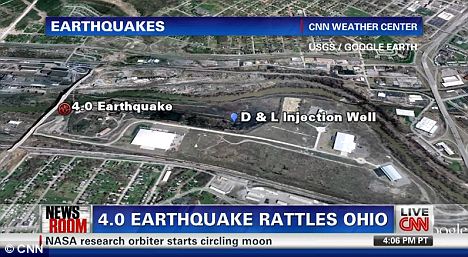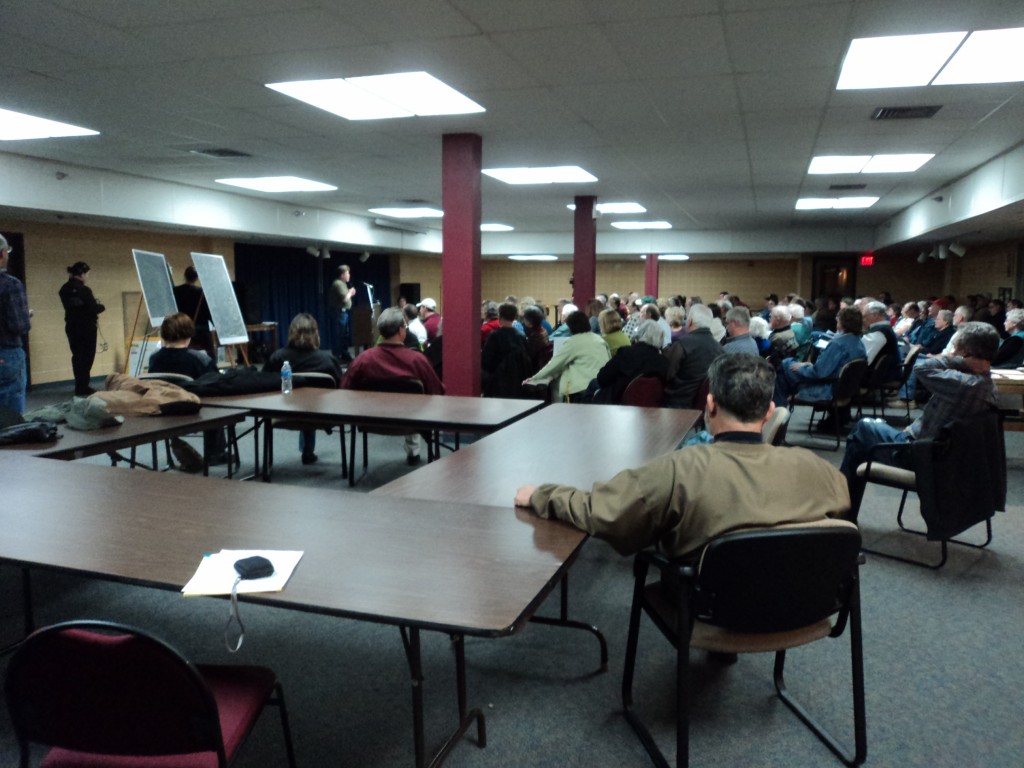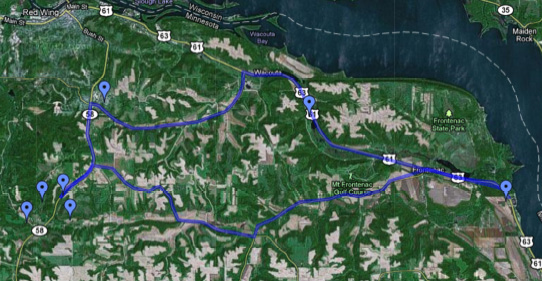Ohio Earthquakes & Fracking
January 1st, 2012
Earthquake in Youngstown, Ohio, the epicenter just a hop, skip and a jump from the D&L Injection Well, pictured above.
Elisa Young in Youngstown sent me this link this morning, noting that “on this Diane Rehm segment the industry specifically states on the air that earthquakes of 2.0 or less (like they can control an earthquake in progress) are beneficial to the drilling company because it shows them the fracking is working. …but fracking and injection don’t induce seismic activity in Ohio… ” The section on earthquakes starts at 28:12.
If you don’t have a copy yet, if you haven’t read it, get with it, learn about gas migration and earthquakes, errrrr… seismic events (copies are getting harder to find, price is going up, but I’m glad because it means that people are paying attention and reading this MUST READ book):
Earthquakes have becoming more and more common in Ohio, as in Arkansas, Pennsylvania, Oklahoma, and yes, there is a trend, a connection, and it’s GAS. In this Youngstown, OH case, it’s related to injecting fracking waste into the ground near a fault. How on earth did they get a permit to do this, anyone with half a brain would know that if you’re pumping in, there is bound to be a response!
Ohio’s “Are you ready for an earthquake?” page!
Here’s a sample, from the Columbus Dispatch:
State links quakes to work on wells
By Joe Vardon
The Columbus Dispatch Sunday January 1, 2012 11:34 AM“The 5-mile radius, we were told by our geologists, is an adequate buffer zone” for the fault line, Zehringer said. “There are four other wells, none of them active, but we’re not going to allow any activity to take place in these wells.”
Michael Hansen, of the Ohio Seismic Network, said that even though Northstar No. 1 was shut down Friday, there is still potential for more quakes, although the magnitude of yesterday’s quake may have relieved some of the pressure near the fault line.
There are 177 injection wells throughout the state. Zehringer and other officials, speaking on a New Year’s Eve conference call, said the single Youngstown well is the only one of its kind that’s been related to seismic activity since the state started using them in the 1970s.
Kasich officials also stressed that the months-long shaking in Youngstown is not a result of hydraulic fracking — a procedure used to extract oil and gas out of rock formations such as the Marcellus and Utica shale. Discoveries of oil and gas in the shale rock in eastern Ohio has sparked hopes for an economic boon in the state’s Appalachian region.
State Rep. Robert F. Hagan, D-Youngstown, called for a statewide moratorium on injection wells. Hagan said he asked the U.S. Environmental Protection Agency to intervene because of the possibility of another quake.
“We don’t want to overreact,” said Zehringer, who suggested that a wider moratorium in well activity “could devastate the economic livelihood of thousands of Ohioans.”
The magnitude 4.0 quake that struck yesterday afternoon in McDonald, outside Youngstown, is the largest of the 11 quakes that originated there, Hansen said.
Residents said a boom accompanied the shaking yesterday. Sheriff’s dispatchers from several counties in the area said there were no immediate reports of damage.
Rick Simmers, chief of oil and gas management for the ODNR, said a daily average of about 5,000 42-gallon barrels of brine water — a byproduct of oil and gas drilling — were pumped into the well, down to 9,200 feet. He said a majority of the water comes from Pennsylvania wells.
Gov. John Kasich, who is vacationing with his family in Florida for the holidays, was in constant contact with Zehringer and other senior staff members throughout the day yesterday, communications director Scott Milburn said. “The governor directed director Zehringer to put public health and safety first and to make a response that is reasonable and appropriate and based on science,” Milburn said.
The well’s owner, Northstar Disposal Services LLC, which agreed to stop injecting brine into the well on Friday, applied for and received licensing under the Strickland administration, Kasich spokesman Rob Nichols said. The No. 1 well has been active since December, 2010, according to Nichols.
Information from The Plain Dealer was included in this story.
Fracking sand mine video from Jim Tittle
May 31st, 2011
Rumor has it that there’s a fracking sand mine in the future down by Hay Creek. More on that here:
There’s a similar operation just across the river in Maiden Rock that’s grown with the natural gas surge, and here’s a video by Jim Tittle of what people who have to live with that mine think about it:
It’s not just about living next door. Stopping our Hay Creek mine is one part of the picture, that sand is the start of fracking, and stopping it is one thing we can do to slow the destruction of aquifers, land, and communities when natural gas drilling comes to town.
Are they frackin’ insane?
April 21st, 2011
There was a meeting at the Red Wing library Monday night about the rumored fracking sand mine south of Re d Wing, and just north of Hay Creek. By the time the meeting was underway, it was standing room only.
The article from the Red Wing Republican Beagle is down below.
Here’s a post with some details of this project to be:
No frackin’ way!!!
Goodhue County’s Article 14 covers mining, but so far it’s been aggregate, and not silica, and it’s a different process, whole different sort of mining, so my thought is that Article 14 needs some amendments. A ordinance change application is just $500 and some work to draft language…
Here’s a map — the site is on the left, and the transfer station in Florence Twp. is on the right, a railroad spur west of Hwy 61 near Hanson’s Harbor:
Citizens turn out in large numbers against possible Goodhue County sand mine
By: Regan Carstensen, The Republican EagleThey got their 10 people – 10 times over.
Silica sand, as opposed to normal sand, is worth about $1,400 per ton.
For more info on the other end of the process, what they use the sand for (fracking) and to learn about what they’re doing with proppants:
In the New York Times (very interesting to learn that instant coffee is used!!!):
Millions of Gallons of Hazardous Chemicals Injected Into Wells
And here’s how bad it’s gotten in Pennsylvania:
PA DEP, Marcellus Shale Coalition Admit Drilling Wastewater Likely Contamination Drinking Water
No frackin’ way!!!
April 5th, 2011
Community Meeting
Red Wing Library
Monday April 18, 2011 @ 6:30 p.m.
Heard a while back that some gas company had bought land for big BIG money in Hay Creek Twp on both sides of Hwy. 58. HUH? Whatever for?
FRACKING SAND!!!
Recently another company, a different company, expanded a sand mine in Maiden Rock, and the sand is for use in fracking, used in drilling for natural gas. An article on that mine:
Here’s a page for a fracking sand corporation that’s a subsidiary of Fairmont Minerals, parent of Wisconsin Industrial Sand Company, and which has many other companies and names too… they’ve got mines in Maiden Rock and Hager City, WI, just across the river from here:
Fairmont Minerals is in the process of expanding that mine in Maiden Rock. Here’s the Santrol Proppants product guide:
In Hay Creek Township, in Goodhue County, it’s supposedly Windsor Permian, which is in the gas drilling business… or as they say, “acquisition, exploration, development and production of high quality oil and gas reserves throughout the United States.” Want to learn something about them? Check their “History” page… oh… “Under Construction.” Rumor has it that Windsor Permian is owned by Wexford Capital, LLC, a hedge fund managed by Charles Eugene Davidson. I’ll keep digging.
The sand? The plan is to mine it and ship it by truck, lots of trucks, to a site along Hwy. 61 in Frontenac!
One person’s take:
… and …
… and …
What does Goodhue County have to say about it? What authority, restrictions, conditions, requirements?
Back to fracking. What is it?
Pretty cool, in the opener, they also answer my question, what the hell is a “proppant?”
And here’s a few words from the Wiki about the sand, something that should concern those of us near any mining operation:
Fracking has utterly screwed up Pennsylvania, where gas well are covering the countryside, New York too… I’m on a natural gas drilling list that contains some of the most distressing news ever, and to think that here in Goodhue County we’re contributing to that with our sand… and we’ll pay for it in the particulates spewed about hat go into our lungs, the massive truck traffic necessary to sustain this operation… eeeeeeeeeeuw, I do NOT like the sound of this.
If you’re interested, head on over to the meeting at the library:



